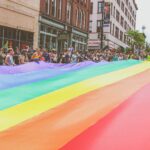The first Pride parade was held on June 28, 1970, in New York City to commemorate the one-year anniversary of the Stonewall uprising, a series of protests by members of the LGBT+ community against police brutality. The parade was initially intended to be a political demonstration calling for LGBT+ rights and visibility. The organizers of the parade wanted to create a sense of unity among the LGBT+ community and raise awareness about the struggles they face.
Over the years, Pride parades have evolved into vibrant celebrations of diversity that bring people of all sexual orientations, gender identities, and backgrounds together to honor and celebrate LGBT+ culture. Today, Pride parades are often characterized by colorful floats, lively music, and elaborate costumes. Participants march in the streets and dance to music, giving a message of love and acceptance to all the people around.
As Pride parades have grown, so too has the number of people who attend them. Pride parades are now celebrated worldwide, and they draw millions of people each year. In addition to the traditional parade, there are a variety of other events that take place during Pride season, including concerts, spoken word performances, film screenings, and more – all of which honor and celebrate the achievements and resilience of the LGBT+ community.
Of course, the political component of Pride parades remains essential. Today, the fight for LGBT+ rights continues, and Pride parades still serve as a way for the community to advocate for change. Alongside the celebration and revelry, Pride parades also serve as a platform to draw attention to issues currently facing the LGBT+ community, such as discrimination, hate crimes, and legal inequality. The political component of Pride is a part of the diverse fabric of a movement that embraces all types of expressions, and it is the same component that ensures these events remain relevant and valid.
As Pride parades have grown and changed, so too has the world around them. Governments and public institutions from around the globe have begun to recognize the importance of Pride celebrations, often marking the day with official proclamations and signage. For many people, Pride has become a symbol of progress and hope.
In summary, the evolution of Pride parades is a testament to the resilience and passion of the LGBT+ community. It started as a political demonstration to demand visibility and rights, and it grew into a vibrant celebration of diversity, inclusion, and love. The fights for equality are crucial, and they still need to continue even after all the progress that’s been made, but everything is with the idea of keeping creating a world of love and respect. Today, Pride parades take place in hundreds of cities worldwide, and they are a testament to the power of community, acceptance, and social progress.
